Subscribe now to get notified about IU Jharkhand journal updates!
Retail Image and Customer Perception with special reference to Reliance Retail
Abstract :
This paper explores the different parts of the store image, which influence the impression and inclinations of customers. It contends that the degrees of customer preferences decide the impact of the setting of the store on its picture. Contemplating customer observations on store image further upgrades the information on advertisers; advertisers can utilize this information in obtaining progressively loyal clients and meeting their prerequisites regarding store image. This investigation recognizes the elements that are esteemed to be the most significant by customers and furnish advertisers with mindfulness regarding the mental components of customers that impact their impression of the store picture. An overview was led on customers in shopping centers to recognize the impacts of the chief components of the store picture on client recognition.
This study uses analysis as the key expository tool for directing causal assessments and researched the critical impacts of store image prospects (i.e., store environment, music, stock quality, administration, cost, and accommodation) on customer perceptions. Results showed that the view of customers indicates the entirety of the signs and messages they have received and experienced in the store, notwithstanding their impression of the significance of store image measurements.
Keywords :
Retail Image, Customer Perception, advertisers, messages, measurement.1. Introduction
Marketing specialists have featured that product utilization doesn't just infer the demonstration of purchasing, yet in addition includes the demonstration shopping and how it is utilized as a pleasurable apparatus. Where items are being sold has a social criticality for individuals. The social affiliation that the customer identifies with the shopping experience depends on the store condition. Building up the store environmental factors by giving them a social essential from the customer viewpoint will help structure the image and notoriety of the retailer. Store image impacts customers, therefore, store fashioners and managers are starting to comprehend the significance of knowing the realities that customers look for in choosing the store they visit and the items they buy, just as the noteworthiness of picking up customer loyalty. Information about these basic perspectives that are affected by store configuration can be utilized as an answer for empower proof based store structures.
Customers partner their sentiments, contemplation's, and impressions with the stores, and these components influence their support and buy conduct. The buy selections of customers are impacted by the store image. The repurchase goal and the fulfillment got from shopping at a store are prompted during the underlying buying stage in which the clients partner their feelings with the store image. Consequently, the impression of clients with respect to a store is created by the store image, and this discernment is connoted by their repurchase goal and fulfillment levels.
However, agreement is missing with respect to the traits that expansion consumer loyalty dependent on store image. Consequently, this issue of store image ought to be additionally examined. Retailers and storekeepers should distinguish the powerful traits for improving the image of their stores. Customers fabricate a view of the store dependent on their various visits to the store, and that the last impression is a mix of the entirety of the parts of the store that have influenced them.
The perception of customers is gotten not just from their insight with respect to the item alone, yet additionally from their apparent pictures of the item. Perception is the phase that a customer or an individual experience in choosing, improving, and deciphering outer triggers into a strong picture. Individuals for the most part decipher truth dependent on observation instead of the genuine reality. Assessments are made dependent on information got from signals that exist remotely.(Schiffman and Kanuk , 2014)
Literature review
A few theories are proposed to legitimize the objective of the present examination after critically reviewing the existing literature.According to (Lindquist, Erdem et al, 1999), the notoriety of the stores alludes to the impression of the stores in the minds of the buyers. Segments that structure the notoriety of a store incorporate its legacy, area and past record of unwavering quality. Contingent upon the quality of their chronicled foundation, stores venture themselves as either being up-market, normal or essential. According to (al., 2014), Purchase goal and the genuine buying process are influenced by the passionate condition of a customer. A calming and inviting store climate stirs a positive passionate state and actuates customers to invest more energy in the store. In this way, the present investigation places the accompanying speculation:
According to(Areni , 2003), the discoveries of researchers and retailers, revealed that when the correct music is played, customers wait longer in the store, are attracted to or repulsed by the store, and are urged to buy or debilitated from shopping. According to (Morin et al., 2007), alleviating music creates a positive result regarding administration assessment and buying choices. According to (Geistfeld, 2003), stores whose promoting techniques are not lined up with the desires of their customer (e.g., not showing the product that clients like) would eventually lose their customers. As per (Thang and Tan and Collins-Dodd and Lindley, 2003), stock as the most basic property of store determination inclination.
According to (Newman and Patel, 2004), customers assess the administration rendered; great help initiates customers to impart their positive experience to others through informal advertising and enhances customer loyalty to the store.According to (Hu and Jasper , 2006), great customer care initiates customers to get a decent view of the store and its items.
According to (Zeithaml, 1988), at the point when customers get the quality that they expect of an item, they hence offer a high incentive on the item. The item cost and nature of the got item are interpreted as the worth given to the item.According to ( Kalyanaram and Winer, 1995), customers think about costs when settling on an item.According to (Kim and Jin , 2001), accommodation is one reason for customer perception for multinational stores over national stores. Another significant thought as far as comfort are store hours, or the opening and closing time.
Research objectives
The main objective of organizations behind customer perception observation study is absolutely to comprehend the choices made by shoppers and take proper measures to impact them. Customer observation hypothesis is embraced by organizations before the dispatch of a item or brand. This examination intends to explore how individuals' observations reach out to important ideas, for example, store picture, trust and fulfillment. The motivation behind the examination was to discover how the store image and look of the store assumes a job on how customers see that store, both with regards to the real store itself, how the customer encounters the administrations they get and other store picture qualities. The point is in this manner to investigate existing client's impression of the store.
The objectives for this investigation are:
- To decide if a relationship exists between the store decision and demographic factors (age, sex, marital status, education level, occupation and income) respectively.
- To examine the significance of store image measurement's and sub-measurements for purchasers in a perfect retail location.
- To exactly research and conceptualize the connection between a store's image and a customer's purchasing conduct.
- To recognize segments of store image that customers may consider significant in store choice procedure. To decide the fluctuation in the general qualities of the store dependent on age, sex, marital status, education level, occupation and income.
Research methodology
The research methodology which I have used for my research purpose is secondary research work because of the pandemic, we can’t go anywhere and collect simply it means that we can’t dio any type of field work. So, I have made a questionnaire for my research to fetch the data from the different customer about their buying perception. Also I have kept the language of the questionnaire simple and not used any type of bookish term which might confuse or which can not be understand by the normal peoples.
This examination researches the impacts of generous autonomous factors of Store Image, specifically, Store Atmosphere, Music, Merchandise Quality, Price, Service, and Convenience at the Store, and a needy variable, Customer Perception. Thus, a survey was conducted among customers in different shopping centres. The sample population was obtained from the students of different colleges and among the households.
Outcomes and Interpretation of Outcomes
In total I have done 80+ tests on my data set from which only the outcomes which have significant difference in their outcomes, I have mentioned here. I just do percentage analysis on the basis of data which was collected by me and converted it into charts.
Frequency of Age
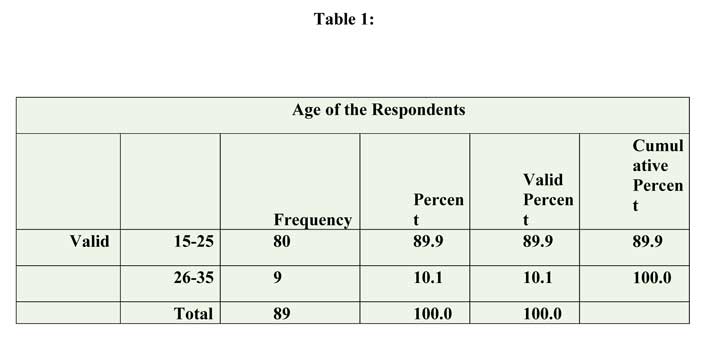
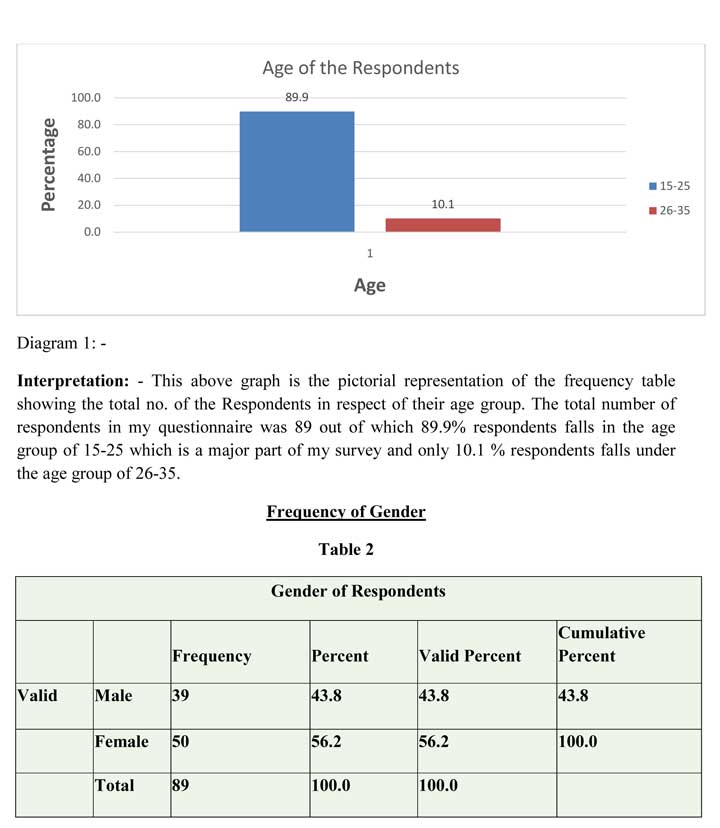
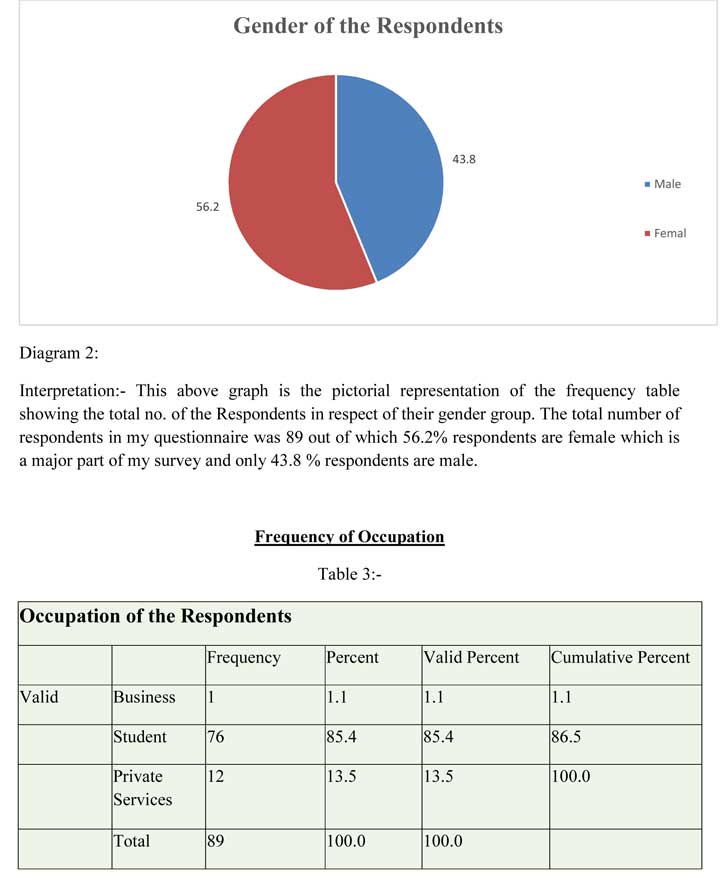
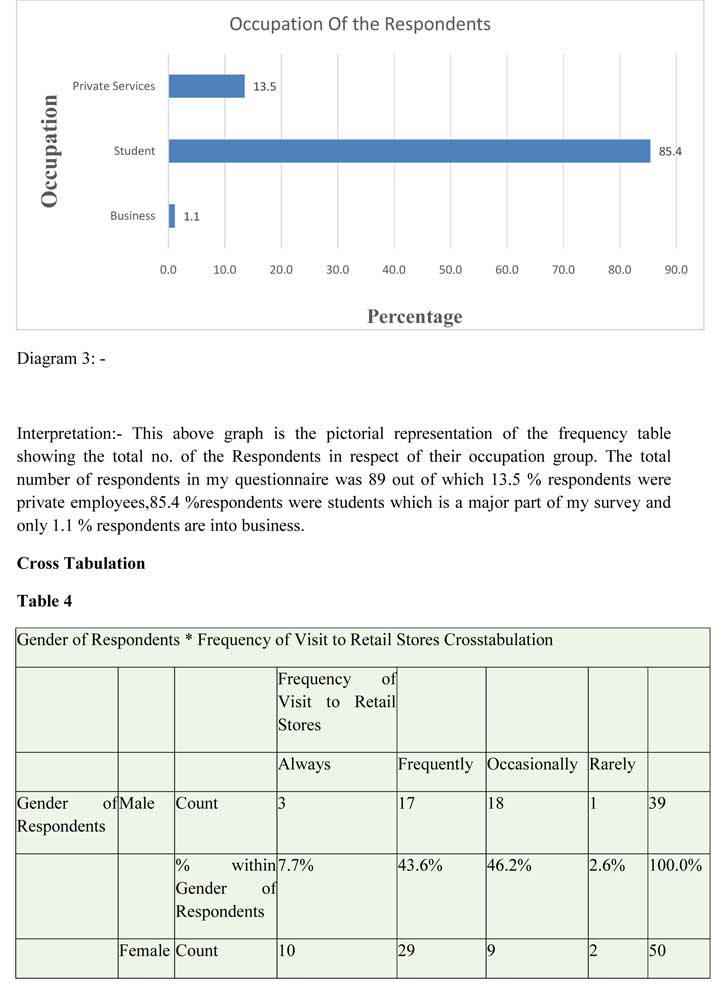
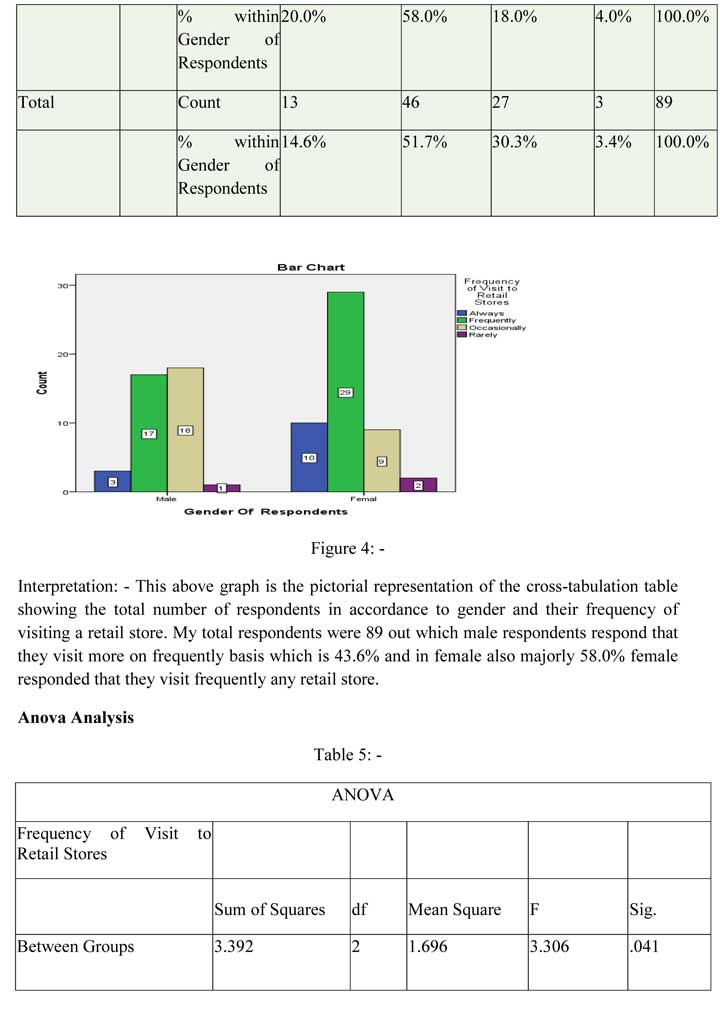
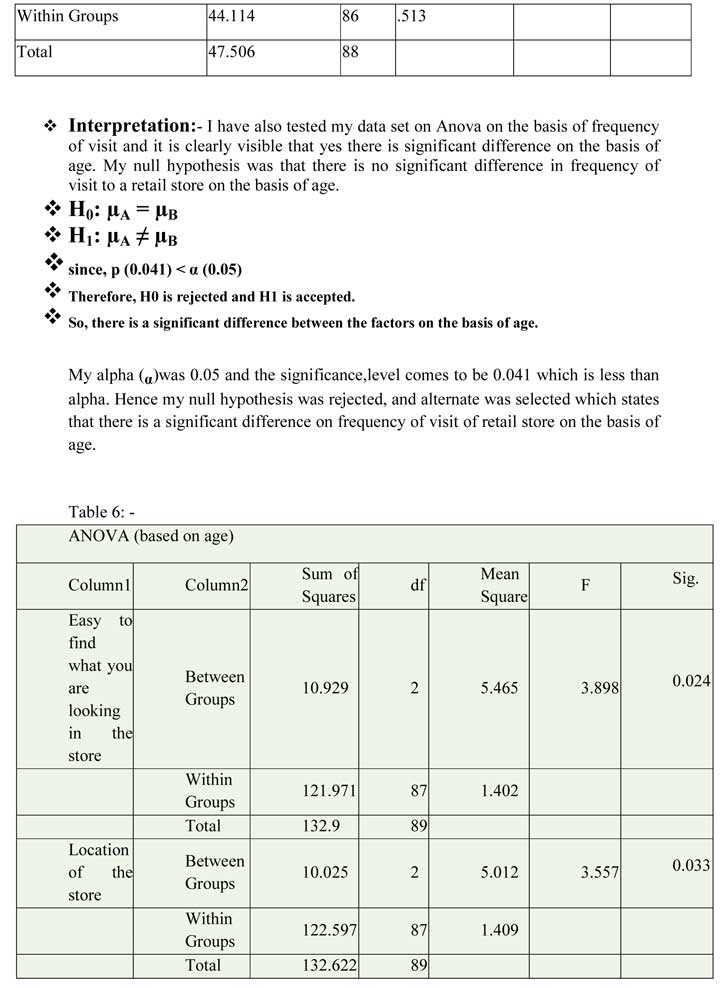
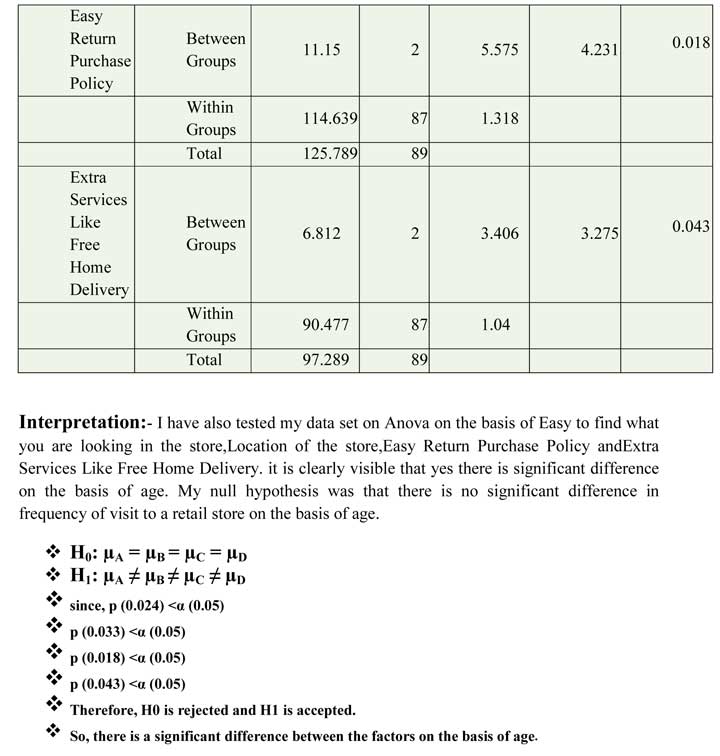
My alpha (α)was 0.05 and the significancelevel comes to be 0.024,0.033,0.018,0.043 respectively which is less than alpha. Hence my all null hypothesis was rejected, and alternate was selected which states that there is a significant difference onEasy to find what you are looking in the store,Location of the store,Easy Return Purchase Policy andExtra Services Like Free Home Deliveryon the basis of age.
Conclusion
Certainly Reliance Retail knows better how things are to be done all across, they are one of the most preferred conglomerate in India and have their presence in almost all the industries, ranging from mining to fashion, but sometimes I believe that it is possible for them to miss onto those issues that might be extremely small for a corporate level but plays a major role when coming down to their operational value on day to day basis. The suggestions I provided are extremely layman and are seen from the eyes of a learning student, maybe sometimes when we see all the big stuff, we kind of ignore the small stuff.
Hence I believe that this small research just made easier for any premium outlet to access what are the factors that they need to pay attention to win the hearts of their customers, because that is why they are there ultimately, to serve their customer over and above something ‘just merchandise.’ Premium stores ultimately just do not deliver merchandise, yet they strive to deliver ultimate shopping experience to their customers.
In conclusion to my all the above findings and methodologies that I carried out; I am glad that I could prove that yes retail store image influence how your customers behave while making purchases through a premium store. My intention behind focusing again and again on the word ‘premium’ is to drive attention to the fact that this might not be valid for other stores who might focus on low cost strategies such as Brand Factory. Hence these findings and conclusions are only with regards to premium outlets. We now also know that customers of such outlets or such brands expect highly courteous behavior from the staff and the things that matters most to them is the staff courteousness.
References
- https://www.ibef.org/industry/retail-india.aspx
- https://relianceretail.com/index.html
- https://www.ril.com/OurCompany/CSR.aspx
- https://www.ril.com/ResponsetoCOVID-19.aspx
- Kalyanaram, G., & Winer, R. S. (1995). Empirical Generalizations from Reference Price Research. Marketing Science, 14, 161-69
- Areni, C. S. (2003). Examining managers’ theories of how atmospheric music affects perception, behaviour and financial performance. Journal of Retailing and Consumer Services, 10(5), 263-74.
- Geistfeld, P. a. (2003, October). Store Image and Its effect on Customer Perception. Journal of Retailing, 4(2), 228-233.
- Zeithaml, V. (1988). Consumer Perception of Price, Quality and Value: A Means-End Model and Synthesis of Evidence. Journal of Marketing, 52, 2-22
- Kim, J. O., & Jin, B. (2001). Korean consumers patronage of discount stores: domestic versus multinational discount store shoppers profiles. Journal of Consumer Marketing, 18(3), 236-55
- Lindquist, Erdem et al. (1999). Customer Preference.
- Morin et al. (2007, October 30). Customer Perception Regarding Retail Stores. 10(21), 223-235.
- Newman and Patel. (2004, September). Customer Perception. 10(21), 228-231.
- Schiffman and Kanuk . (2014, October). Store image. 10(21), 223-235.
- Thang and Tan and Collins-Dodd and Lindley. (2003, April). Customer Perception. 10(21), 221-225.
- Zeithaml. (1988). Customer Significance. 11(12), 221-223.
- Hu and Jasper . (2006, September). Customer Perception. 10(21), 221-235.
- (Lindquist; Erdem et al). (1999). Customer Perception related to Store image. Science Direct.
- al., D. e. (2014, October). Store image and Customer Perception. Asian Social Science, 10(21), 223-235.
